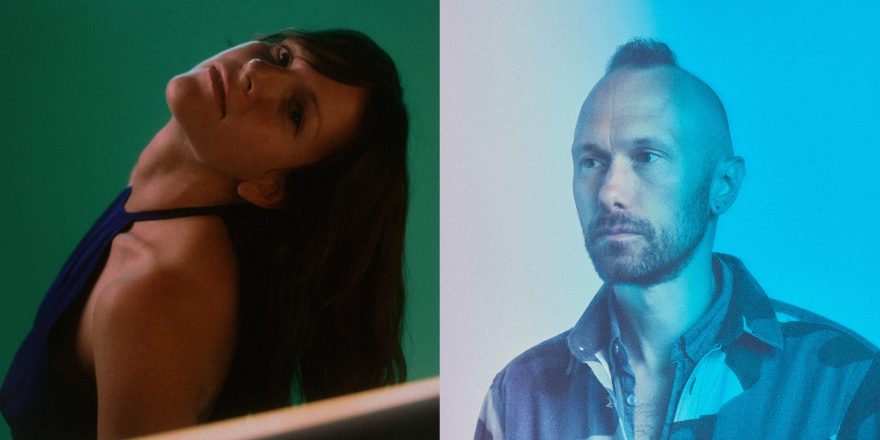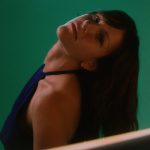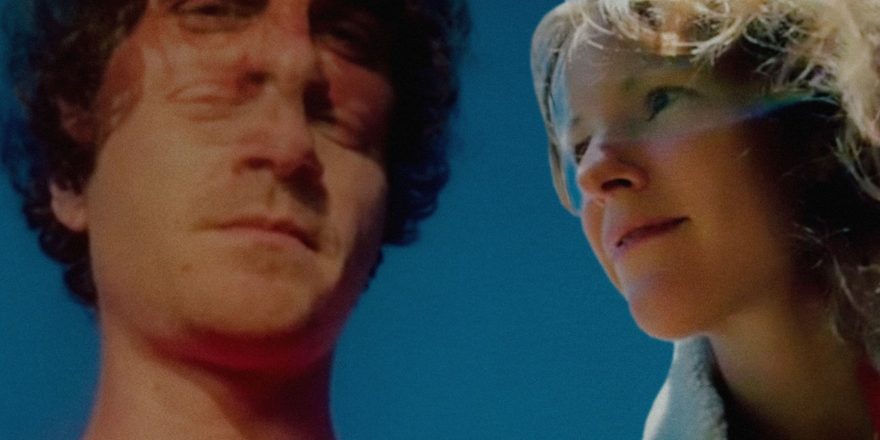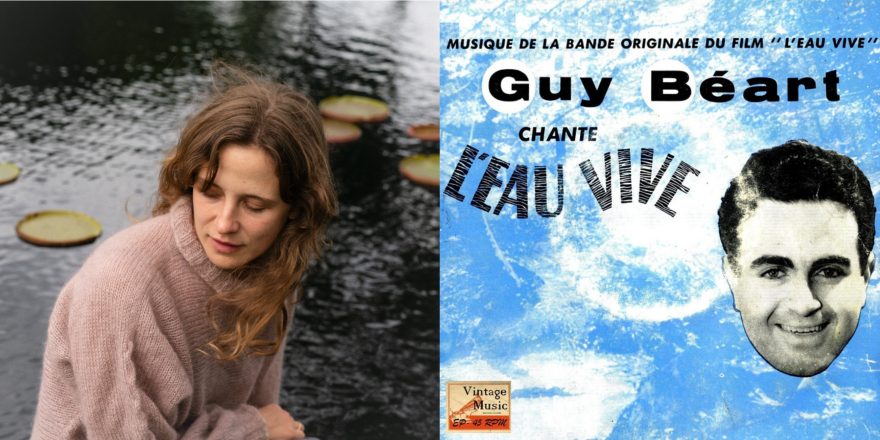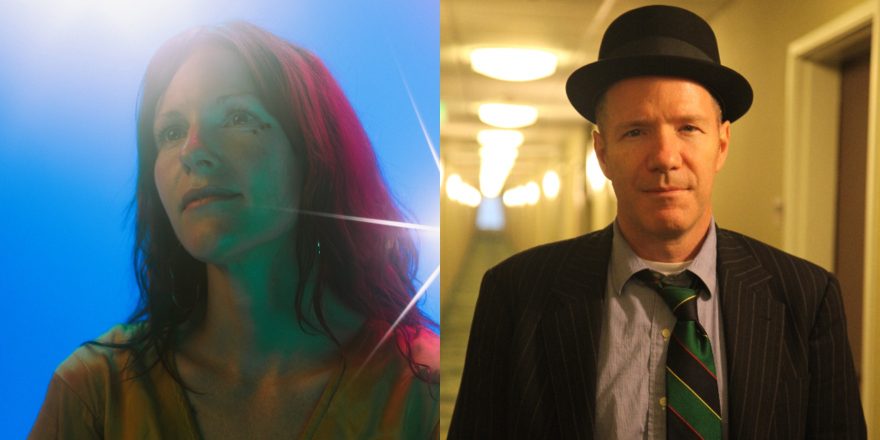Kaitlyn Aurelia Smith is an LA-based composer, performer, and producer; East Forest is the electro-acoustic project of the Portland, OR-based artist Krishna-Trevor Oswalt. East Forest just released his new album, Music For The Deck Of The Titanic (out now on Bright Antenna Records), so to celebrate, he and KAS had a chat about it, the term “ambient,” improv stage fright, and more.
— Annie Fell, Editor-in-chief, Talkhouse Music
Kaitlyn Aurelia Smith: Thank you so much for inviting me to do this, Krishna. I really appreciate it.
East Forest: Yeah, I love what you do.
Kaitlyn: Likewise.
East Forest: I think of you as an innovator and someone always pushing boundaries kind of at the spear tip of a lot of things in contemporary music. So I’m always looking forward to chatting about music with you.
Kaitlyn: Oh, thank you. That means so much to me. Congrats on your new music. How are you feeling about it?
East Forest: I’m feeling good, but — I don’t know about you, when you release stuff — I have strange feelings. I don’t know if it’s postpartum or it’s more like, now what. It’s like you’re supposed to be out there “rah, rah” promoting, and it feels strange sometimes, cause it’s something you made a while ago, and you’re like, I don’t know how to talk about things, or I don’t know how to share it in the same way. But, I’m very excited to have it out there. It’s like a little boat you build and then you kick it out to sea, and it’s out there doing a journey and you don’t feel like you’re on the boat but you’re like, Oh, I’m glad it’s out there meeting people and bumping into things.
Kaitlyn: Totally, I love that analogy. “Strange” is a perfect word to encapsulate it. And it’s kind of neat, because you get to experience your creation objectively after. You get this mutual experience of being attached to it and it still being a part of you, and you get to have a little objectivity where you’re like, That’s my baby out there!
East Forest: [Laughs.] I have a question for you though.
Kaitlyn: Sure.
East Forest: How do you define ambient music, and do you identify with that word? Cause I feel like everyone has different definitions of what it means and they throw a lot of things into that bucket. I identify with it somewhat, but I’m also not even sure if we have any sort of shared agreement on it. Do you identify with it?
Kaitlyn: I appreciate you bringing that question up cause I don’t personally identify with it, but I know a lot of people have used that word with my music — and it doesn’t offend me in any way. I looked up the actual definition of it a while ago, because I wanted to just know what the root of that word is and where it comes from. It seemed so open ended when I read the definition of, “relating to an immediate surrounding of something.” So I can definitely connect with aspects of that word. But I don’t personally gravitate towards any sort of genre word.
East Forest: Yeah, me neither.
Kaitlyn: I’ve always been curious how many musicians identify with genre words or if it’s more just like a means of describing for someone who’s experiencing the music.
East Forest: Right. Here’s another question I had for you: You have been using hardware in a way to almost give you certain brushes and colors to paint with as an artist. And I’m curious — cause I heard from someone recently that you’re a really badass guitar player and that you used to sing.
Kaitlyn: Oh, my gosh, that’s so nice that someone said that.
East Forest: Someone told me that and I was like, “Really? Oh, my god, that’s so cool.” And then I was like, well, you clearly have made choices about why you’re using the colors you’re using right now and how that defines to something that’s hardware based. I’m curious where that came from or what your thoughts are on that.
Kaitlyn: Well, I studied classical guitar, and I love the guitar. Honestly, I fell in love with the tiny stool that you just put your foot on — that was like, Oh, yeah, I just want a tiny stool for my foot. [Laughs.] But I hit a point where, where it felt like I couldn’t make enough sounds that I felt inside of my body with the guitar. And I don’t mean that in a way of limiting the guitar; it’s more user error than to say anything about the guitar. I just personally couldn’t find a collaboration with the guitar in that way. And then when the Buchla came into my life — which opened up my world into sound synthesis — it felt like it connected me to electricity, and that felt like, Oh, that’s the energy that I know how to collaborate with. That’s kind of how I decide which hardware piece to use: how the electricity is flowing through it. And that’s more of just a psychosomatic thing where I feel like there’s a wall between us or I can really feel the electricity.
What about you? what draws you to a certain piece of gear?
East Forest: Well, I’ve gone in phases. I went through a big phase of really getting into acoustic instruments, and then how to record them and getting really jazzed by the sounds — like all the imperfections or the overtones of a piano and the creaking. And on this new record, I was really into drums. But I wanted to record it myself and really get into recording the sound of a particular player and a kit and the saturation and all that. So this record is very acoustic. It’s basically upright bass, drums, piano, vocals, and then some synths here and there. I’ve also always liked recording field recordings and stuff. There’s chaos in things that are kind of real and natural in that way. And maybe that’s true with analog sounds. The difference between an analog synth versus a digital emulation — they’re both electric, right? But one is imperfect and has groove in a sense. And I like that too. I’ve been really into that coming from acoustic sources.
Kaitlyn: I really appreciate when I’ve seen you live, there’s an energy. And I just imagine that you have this with all of the things that you create, where it felt like there was this really palpable attention to little details and the space around the details — like, I was really aware of the space around each detail, and I really appreciated that in your live performance and appreciate that in your music.
East Forest: Thanks. Space is the place, right? I mean, better or worse I’m so into details. And I just feel like that old saying that “god is in the details” — it’s like you put a bunch of details together, and I think it creates a certain zone. I just have never been able to do it in big, broad strokes, where I’m like, I don’t know, it’ll work itself out. Those little things are additive, like little bits of ingredients to a soup. And I do think it translates.
We both use a lot of layers in our music, and I think one thing I heard in your music that I was drawn to initially was like, Oh, you’re coming at this from a very compositional point of view, like [with] more training that I have. I can hear there’s a lead line and there’s a counterpoint. The bass is doing this thing. It’s all there, but it’s the kind of detail that I think makes those pieces work. Because otherwise, it’s just a lot of sounds put on top of each other. [But] no, they’re all supporting one another in different ways.
Kaitlyn: Oh, yeah. It’s like a community. I love the personification of sound so much, and so I love when sounds feel like they’re just like a big group of people supporting each other. [Laughs.] I’m curious. What’s your relationship with the concept of a muse? However you want to answer that…
East Forest: That’s a deep question, because it’s been a lot of things for me. What drives me to make music — on one level, doing it as a job is a real gift because it kind of forces me to keep doing it. You have excuses like, I have a show in two weeks and I have to rehearse, I have to put something together. You have these deadlines and that’s helpful, to be honest. But when I play music, it really helps me get in touch with the things that I feel are lacking in my life, which is like feeling in touch with something bigger than my mind or bigger than my little problems. It’s very emotional for me and I, for better or worse, like feeling in touch with that big emotional feeling. So the muse is sort of, I guess, the bigger thing kind of calling you saying, “Hey, come get in touch with us,” or “Don’t forget about us. Don’t get lost in the weeds of life.” And so I just keep dipping back into that well.
It’s like mental health in a sense. Just being creative, just playing around, is usually enough to feel like, Alright, I’ve put my toe, or my whole leg, or maybe my whole body into that water, and I feel better for today. But then I have to do it again the next day and the next day. And so doing it as a career is very self serving in a way, cause it helps me design a life where I kind of have to keep dipping into that well. I don’t know if that answers the question.
Kaitlyn: Oh, I love that so much. That really resonates. The other day, I was thinking about — and periodically I think about this, which I imagine a lot of artists do, where they have those moments of like, What am I spending my time on? Is art OK? Like, it feels selfish sometimes. And then I go and experience someone else’s art and it saves my life. It bursts me open. And then I remember, Oh, right, it’s not about me at all. Art isn’t really about the person at all. Or at least, the art that I resonate with isn’t about the person at all. It’s like that dipping into what you were just describing, and I feel like people can feel that when that’s what’s behind the initial intention.
East Forest: Yeah, we’re creative beings as people, all of us. I do think that creating in itself is honorable, even if it feels like, How is that helping the world? There’s all these things going on… It’s like a celebration of the human spirit — we can do that, and we should do that. And we need beauty in the world. Like, what is the role of beauty?
You talked about something that I talk about a lot too, which is the role of listening. What does it mean to listen? In all the different shapes and sizes that comes in. If anything, there’s so much noise in modern life that just taking time or learning how to listen to something broader than ourselves is more and more valuable. And music can be a great way to do that, because it’s easy, right? It gives you something to listen to and sort of follow along and track with, and in that, it can open you up to deeper feelings, like broader things or inspiration or understandings that are about felt experiences. It’s more somatic in that way. I think that’s important today, more and more. We lose touch with that.
Kaitlyn: I definitely agree, and I love hearing how much people are starting to really resonate with that. It feels like it’s such a incredible way to connect. That’s my favorite part of playing a show or going to a show, everyone listening or paying attention to the same moment.
East Forest: Yeah, collective processes. And in that, it’s fun to see music happening in front of you. It’s not that it’s not enjoyable to hear something that’s programmed or finished — just pressing play, that’s still kind of like looking at a painting. But if you watch the painting being painted in front of you, it’s even more exciting. And I think we’re hungry for that, to be like, Oh, this is happening, and I’m part of it by paying attention to it, and then it will be over.
Kaitlyn: Yeah.
East Forest: When you’re doing all that stuff live, do you ever get frustrated, like, People can’t see what I’m doing, let alone understand what I’m doing? Cause I’m playing keyboard and even with that, people are like, “You doing a DJ set, man?” They don’t know what’s going on with looping and stuff. Do you ever feel that with all the stuff you’re doing?
Kaitlyn: I mean, I’m sure that people think I’m DJing… I have no idea what people are thinking. I’ve honestly never thought about it, because I always tell myself this funny thing right before I play — but it really helps me. I like tell myself that I’m a pilot and I have to get these people to their destination. [Laughs.] And it makes me just put all my energy into the moment, and it gives me this responsibility. So that’s honestly the only thing I’m thinking about, even though it’s kind of silly. But I’m sure people are — there’s some times at venues where all you see is just a little glow. You don’t see anyone.
East Forest: I saw Tim Hecker play and it was in a theater that was so dark, you couldn’t see a hand in front of your face. I never saw him I didn’t see him walk on stage or off. It was an hour long in pitch black.
Kaitlyn: Well, that’s kind of fun. I like that mysterious… Who knows if anyone’s even there.
East Forest: Yeah. And yet I said I saw him play, but I didn’t actually. [Laughs.]
Kaitlyn: That’s so neat. So what are you excited about with your new album?
East Forest: I’m excited about hopefully still in the future bringing more musicians into the performance. I mean, I’ve been playing solo now for quite a while, and sometimes bringing in people or strings here and there, but I’m excited by the idea of improvisationally playing with a group of people — which may or may not happen. But that’s sort of a leading edge, because that was a lot of the record itself. Also, honestly, I make records and I usually don’t think about how I’m going to play them. And I probably should, but I just like making sounds and music in the studio. I’m like, Oh, I like this. And I have to then put on a different hat later and be like, Should I try and play this? How would I do that? Or do I have to reinvent it? And that’s still a work in progress.
Kaitlyn: Oh, wow, that’s so cool to learn that you don’t think about it as you’re writing it. I feel like that’s a whole other level of musicianship to then be able to figure out the live thing after
East Forest: I feel like being a recording artist and performing artist are totally different jobs. I mean, they’re just different skill sets and processes. I enjoy them both for different reasons, but I don’t have the same crossover in my head where I’m like, Oh, yeah, this is gonna blend into this. Or, I’ve heard acts do it like, “We’re gonna make an album that will do well in arenas, because we’re gonna play arenas.” And that makes sense, I guess, for them. But I’ve never… I just make the music I want to make.
Kaitlyn: It’s so interesting to learn that they’re separate for you. I would love to hear more about that, where your mind goes for creating the music as an album and then where your mind goes for the performance.
East Forest: For studio albums, it’s sort of whatever I’m interested in musically. Like this last one, I was really wanting to record drums — it was as simple as that. I was like, Oh, I’ve always wanted to do that. And maybe it’s very simplistic thinking, but like, I’ll just go do that and just see what happens. It also is what’s happening in your life, right? Like Marieme, who features on several of the songs, she just kind of showed up in my life and we started writing songs. I didn’t think it would be for this album, but then, as the universe conspires, it’s like, “Oh, these might be kind of fun in here.” And then I collaborated with ANNA, who’s a techno DJ, and I didn’t think that’d be part of this, but then later on it was like, “Actually, this might work in this too.” We put drums on top of it, and I was like, “Oh, that’s kind of a glue that holds it together.”
So I really try to make it more of an unfolding versus too much of a plan. And then one day — I love that moment when you’re making a record where it’s like, Wait a minute, I think I’m actually seeing a record here. You know, it starts to cross over that line. And sometimes it surprises me. I’m like, Oh, it’s that. Whaddaya know? It’s gonna be lyrics and groove. Never would have thought that would happen.
Kaitlyn: Isn’t that so cool? I love how creativity is a surprise sometimes.
East Forest: At its best, yeah.
Kaitlyn: It’s always the same process for me, so that’s really interesting to hear that it’s separate for you. Hearing about any artist’s approach is really fascinating to me, just how different we all are. It’s so beautiful.
East Forest: Yeah. And I love collaborating, because it gets me into other people’s worlds. I had a few collaborations this year with Peter Broderick, and that really started getting me thinking about music differently, and so inevitably that bleeds into whatever you’re creating. You’re like, Oh, what if I try that technique, or I approach writing a song completely differently? I just love that.
Kaitlyn: Yeah. Do you ever experience a challenge in your creation ?
East Forest: Yeah. [Laughs.] No, all the time.
Kaitlyn: I wonder if anyone would ever answer no to that.
East Forest: “No, it’s so easy…” [Laughs.] My process has always been one that’s improvisationally based, so it’s just lots of coming in and throwing down some ideas in the moment, and doing that for weeks and weeks and weeks before I listen back. So I kind of build the bones through improvisation, even if it’s in collaboration, and try not to think about it too much. I just experiment. There was a Beck line I liked — he was like, “When you go in the studio, you gotta remind yourself, you’re just making noise.” Just make noise, deal with it later.
Kaitlyn: Oh, I like that release of pressure. Do you ever get nervous before you’re gonna improvise with people?
East Forest: Yeah, if they’re people I respect. I’d be nervous to play with you — if you rip out your guitar, I’d be like, “Oh, boy.”
Kaitlyn: Oh, my gosh, I’d be so nervous too.
East Forest: Your little stool — I’d be like, “Oh, no, she’s a pro!”
Kaitlyn: Maybe I should get a little footstool for the synthesizer. Like, it has no use… [Laughs.]
East Forest: That’d be so cool. My tactic when I’m playing with people, or even myself, is to make it feel as nonchalant and casual as possible. Like, “No big deal, we’re not even starting, but we’re going to make some noise.” Keep it super out of mind, super unspecial.
Kaitlyn: I always get nervous before improvising with someone. I always have imposter syndrome when I’m in a room with another musician, where I’m like, I shouldn’t be here…
East Forest: I definitely get that.
Kaitlyn: I like that you in the beginning just talk about the nervousness.
East Forest: I was playing with someone — this is years ago — Lorraine Weiss, who’s a saxophone player. We were recording some stuff for the Ram Dass record, and she came in and it took a long time. We’re finally there, the microphone’s set up, and I’m just about to say, “Alright, let’s just kind of play some stuff over this.” And she said, “Well, hold on — shouldn’t we do an invocation or some kind of prayer?” And I said, “No. God, no. That’s the last thing I want to do.” It’s like, “This is not really a take. Don’t worry about it. Just make mistakes, hit record.” I have to do that.
Kaitlyn: There’s so much fun when you allow yourself to mess up. I honestly feel like I have the most fun when I mess up. It brings me to a giggle place every time.
East Forest: Yeah, you gotta allow yourself to be human. And you’re always pushing and finding those edges too. You’re always growing as a musician and a player, and you only do that by finding those edges. Like, I wonder if I could do this… Well, not quite, but maybe tomorrow, or maybe in a year. But you just keep trying things.
Kaitlyn: I know. I always want there to be more — and maybe this does exist and I am not aware of it, and now I’m asking the universe to bring it towards me — but the kind of pressure free artist support groups where you can just play around with ideas. And not in a jam, but like people sharing challenges that they’re experiencing… Yeah, I don’t know, like an artist support group.
East Forest: Sign me up.



